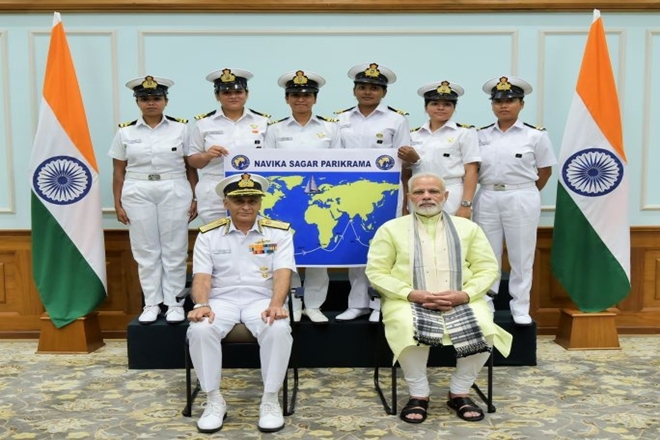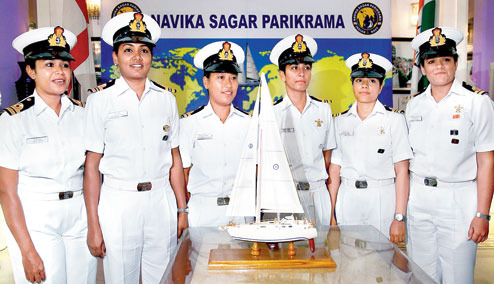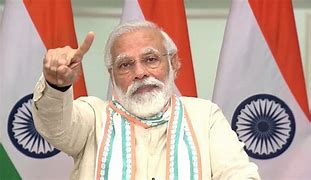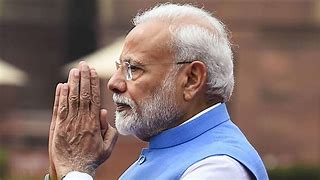Feature
Six Indian women officers to grab India’s naval ambitions

New Delhi: Women now days is achieving new things in every front, once again a Indian women officers is all set for an eight-month stint riding sea waves. For the very first time they will be leading a mission unlike any undertaken by Asian women.
Vartika Joshi is one of six women officers from the Indian Navy who will set off from Goa in the first week of September to circumnavigate the earth on a sailing boat in a bid to create history and lend greater heft to India’s budding naval ambitions.
The first Asian women’s team ever to attempt such an adventure, the six – from different corners of the country – will bounce across some of the roughest seas in the world, stopping just four times on the way. They will crisscross the equator twice and the international dateline once.
No military women’s team anywhere in the world has circumnavigated the earth till now, the navy said today as Joshi’s group – all in their 20s – sat before clicking cameras, clearly more accustomed to the sea than to flashbulbs.
The team has trained for the past three years with the now retired Captain Dilip Donde, the first Indian naval officer to circle the earth in 2009-10, and has sailed increasingly long distances as part of their preparation.
Only one other Indian officer, Cadre Abhilash Tomy in 2012-13, has circled the earth – he did it without stopping anywhere, the second in the world to do so.
But the adventure isn’t about showcasing endurance alone. It’s a reminder of the navy’s slow but steady embrace of women officers in sailing roles – a handful already flies jets but Joshi will be the first to captain a vessel.
Equally, the mission is India’s latest demonstration of its increasing maritime capabilities and aspirations to the world and its troubled neighbourhood.
“You can climb a mountain to test your endurance, but what we’re doing here is looking not inland but outwards to the world, and training young officers to think that way,” Tomy told the media “You do that for a generation, and you will be a major naval power.”
The officers – Lt Cdr Joshi from Rishikesh, Lt Cdr Pratibha Jamwal from Kullu, Lt Cdr Swathi P. from Visakhapatnam, Lt Aishwarya Boddapati from Hyderabad, Lt Vijaya Devi from Moirang Kwakta Santhong in Manipur and Lt Payal Gupta from Dehradun – will set off southeast.
Their sail boat, the Indian Navy Sailing Vessel Tarini, will carry 600 lt water, a reverse osmosis plant and dry supplies for food that the officers will use to cook, Joshi told this to newspaper. The vessel has no refrigerator.
They will sail first to Freemantle in Western Australia, a journey expected to take 37 days. Their next stretch will be shorter – 22 days – before they stop at Lyttleton in New Zealand, but the Tasman Sea is notoriously rough.
They will confront their toughest test next, when they sail for 35 days from New Zealand to Port Stanley in the Falkland Islands, below the southern tip of South America – the closest point to Antarctica.
There, Donde said – recalling from his own experience – temperatures are between 4-5 degrees C, the winds are howling, and the waves are twice the size of their counterparts in the Indian Ocean.
“If the waves there are less than 10 feet high, it’s a good enough day to celebrate by frying some dosas,” Donde said. From the Falkland Islands, the women will sail to Cape Town – a journey expected to take 28 days – before their final leg back to Goa, which is estimated to take 42 days.
The officers will hope to build on a relatively young legacy. The navy came up with the first of its circumnavigation initiatives – called Sagar Parikrama – in 2007, and commissioned Aquarius India, a Goa-based company, to develop the boats for the project indigenously.
“It’s a fully ‘Made in India’ initiative,” said Vice Admiral A.K. Chawla, the chief of personnel of the Indian Navy.
Donde and Tomy sailed on the INSV Mhadei – with a wooden frame sandwiched between layers of fibreglass – and it was on that boat the six women officers also trained initially. In February 2016, Joshi’s team sailed on their maiden independent voyage from Visakhapatnam to Goa.
Then, they tested themselves with a sortie from Goa to Mauritius and back. Next, they sailed from Goa to Cape Town and back. The Tarini – designed exactly like the Mhadei – was inducted in February 2017, and the officers tested their new boat with a series of sorties – from Goa to Mumbai, and then Goa to Porbandar.
They returned from their final test sail – to Mauritius and back – on the Tarini only last month. “We learned everything from scratch – whether it was how to repair stuff, or rescue someone in an emergency,” Joshi said. On Wednesday, the officers met Prime Minister Narendra Modi.
Their route around the world isn’t either the smoothest or the shortest way to pass by all continents and return to Goa. But to legitimately claim circumnavigation, teams must follow certain rules.
They must not only cross all meridians and return to the spot they started from – but must avoid straits and canals. They must cross the equator twice and the dateline once, round the great capes – the southern tips of Africa and South America – and must travel more than 21,600 nautical miles, the circumference of the earth.
Apart from their laptops and books, the officers will have satellite phones they can use to communicate with land. But though there is no bar on speaking with family members, Tomy said he avoided it during his five-month, non-stop journey. “You have a task at hand, I found it best to focus on that,” he said today.
For at least some of the officers, though, the biggest challenge ahead isn’t either the time away from home or the prospect of rough seas. It’s the future, after they return from their adventure.
The Indian Navy, Chawla said, is committed to moving towards allowing women at sea on ships. “We are committed to it, and are working towards it, over a period of time,” he said, calling the women “pioneers” who will “set a new benchmark”.
Entertainment
Meghalaya Reserves Legalized Gambling and Sports Betting for Tourists

The State Scores Extra High on Gaming-Friendly Industry Index
Meghalaya scored 92.85 out of 100 possible points in a Gaming Industry Index and proved to be India’s most gaming-friendly state following its recent profound legislation changes over the field allowing land-based and online gaming, including games of chance, under a licensing regime.
The index by the UK India Business Council (UKIBC) uses a scale of 0 to 100 to measure the level of legalisation on gambling and betting achieved by a state based on the scores over a set of seven different games – lottery, horse racing, betting on sports, poker, rummy, casino and fantasy sports
Starting from February last year, Meghalaya became the third state in India’s northeast to legalise gambling and betting after Sikkim and Nagaland. After consultations with the UKIBC, the state proceeded with the adoption of the Meghalaya Regulation of Gaming Act, 2021 and the nullification of the Meghalaya Prevention of Gambling Act, 1970. Subsequently in December, the Meghalaya Regulation of Gaming Rules, 2021 were notified and came into force.
All for the Tourists
The move to legalise and license various forms of offline and online betting and gambling in Meghalaya is aimed at boosting tourism and creating jobs, and altogether raising taxation revenues for the northeastern state. At the same time, the opportunities to bet and gamble legally will be reserved only for tourists and visitors.
“We came out with a Gaming Act and subsequently framed the Regulation of Gaming Rules, 2021. The government will accordingly issue licenses to operate games of skill and chance, both online and offline,” said James P. K. Sangma, Meghalaya State Law and Taxation Minister speaking in the capital city of Shillong. “But the legalized gambling and gaming will only be for tourists and not residents of Meghalaya,” he continued.
To be allowed to play, tourists and people visiting the state for work or business purposes will have to prove their non-resident status by presenting appropriate documents, in a process similar to a bank KYC (Know Your Customer) procedure.
Meghalaya Reaches Out to a Vast Market
With 140 millions of people in India estimated to bet regularly on sports, and a total of 370 million desi bettors around prominent sporting events, as per data from one of the latest reports by Esse N Videri, Meghalaya is set to reach out and take a piece of a vast market.
Estimates on the financial value of India’s sports betting market, combined across all types of offline channels and online sports and cricket predictions and betting platforms, speak about amounts between $130 and $150 billion (roughly between ₹9.7 and ₹11.5 lakh crore).
Andhra Pradesh, Telangana and Delhi are shown to deliver the highest number of bettors and Meghalaya can count on substantial tourists flow from their betting circles. The sports betting communities of Karnataka, Maharashtra, Uttar Pradesh and Haryana are also not to be underestimated.
Among the sports, cricket is most popular, registering 68 percent of the total bet count analyzed by Esse N Videri. Football takes second position with 11 percent of the bets, followed by betting on FIFA at 7 percent and on eCricket at 5 percent. The last position in the Top 5 of popular sports for betting in India is taken by tennis with 3 percent of the bet count.
Local Citizens will Still have Their Teer Betting
Meghalaya residents will still be permitted to participate in teer betting over arrow-shooting results. Teer is a traditional method of gambling, somewhat similar to a lottery draw, and held under the rules of the Meghalaya Regulation of the Game of Arrow Shooting and the Sale of Teer Tickets Act, 2018.
Teer includes bettors wagering on the number of arrows that reach the target which is placed about 50 meters away from a team of 20 archers positioned in a semicircle.
The archers shoot volleys of arrows at the target for ten minutes, and players place their bets choosing a number between 0 and 99 trying to guess the last two digits of the number of arrows that successfully pierce the target.
If, for example, the number of hits is 256, anyone who has bet on 56 wins an amount eight times bigger than their wager.



























